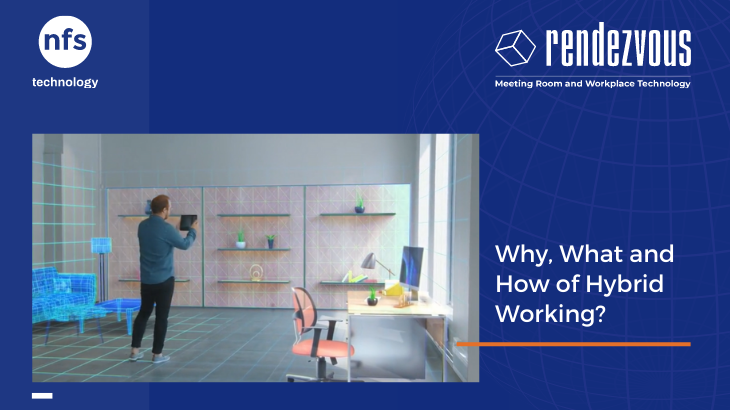Serving 1800+ customers
across 40 countries
Hybrid working with hybrid workplace solutions
Hybrid working offers the best of both worlds: access to technology and collaboration in the office and the opportunity to create a better work-life balance at home. What started as a necessary health and safety measure, the hybrid workplace solutions have grown to become the standard for knowledge workers all around the world.
The Rendezvous enhanced employee experience
The evolution of hybrid working is being driven by
these 3 factors:
Better space utilization
With more people working from home permanently or a few days a week, how organizations use their space is a hot topic.
You need to organize your space in a cost-effective way that also makes sure your staff have access to all the resources they need in the office whenever they need them.
With changes in how workers interact with the building, it is vital to have accurate utilization data to drive future change. This can be made possible with hybrid workplace solutions.
The employee agenda
Now that employees have had a taste of home working, it can be difficult to persuade them to spend time in the office.
To retain talent, you need to offer flexibility, a great digital experience, and a move towards working styles more focused on outputs than on location.
The working agenda
For hybrid working to get buy-in from management post-Covid, leaders need to demonstrate that this way of working generates more productivity.
A key driver of productivity is the digital experience. Hybrid workplace solutions need to be mobile, time-saving, data-driven, and ensure maximized space utilization.
How Rendezvous provides the perfect hybrid working software toolkit
Desk booking
Unallocated seating is now a reality for many organizations, and demand for seating can be outstripped by supply. Adopting a hoteling strategy is a great way of ensuring your limited space is fully utilized while maintaining maximum occupancy. This can be implemented with a hybrid workplace management system.
A desk booking solution ensures your staff is guaranteed a desk when they commute to the office. Features like auto-release for no-shows make sure optimum seating levels are maintained.
Innovations like floorplan booking via a mobile device make it easier for your staff to use hoteling. Integration with Outlook ensures that all their desk bookings are logged automatically for future reference and added convenience.
Further hybrid workplace software integrations – with QR code readers and desk panels, for example – enable employees to check in and out of their desks quickly and safely. New features such as “find a colleague” ensure they get the necessary face time for collaboration and mentorship – two key reasons for working in the office.
Sensor technology
Where space is less of an issue, booking a desk in advance is less necessary. A more free-wheeling hot desking approach can be adopted, and sensor technology is ideal with workplace software.
Instead of booking in advance, workers simply arrive at the office and check desk availability on digital signage connected to the occupancy sensors. They can immediately see which desks are free, walk up to the desk, and check in automatically as the sensor detects their presence. When they walk away, they are checked out.
Sensor technology provides accurate real-time usage data that can drive future real estate decisions. As part of a wider suite of hybrid meeting workplace software, integrating sensors with meeting room booking software gives pinpoint, accurate data on how staff are interacting with the space. Effective sensor integration into a meeting room booking system can lead to more efficient room allocation, improved energy management, and enhanced user satisfaction, ultimately contributing to a more productive and sustainable workplace environment. Rendezvous helps you do just that and more. Here are a few ways sensor technology can help improve your hybrid workplace environment and help organizations make informed decisions about room allocation and resource management.
Occupancy sensors are a part of hybrid workplace technology and detect whether a meeting room is currently in use. When integrated with a meeting room booking system, these sensors provide real-time occupancy data, which is important for real estate leaders and facility managers. Occupancy sensors can determine when a meeting has started or ended and automatically update the room's availability status in the booking system.
Occupancy sensors are used to power room availability displays located outside meeting rooms. These displays can show the room's current status in real-time, making it easy for employees to find and book available spaces on the spot.
These sensors can facilitate automatic check-in and check-out processes for meetings. When a scheduled meeting is in progress, sensors can detect the presence of participants, and when the meeting ends, they can check out the participants, making the room available for the next booking.
Sensor technology helps streamline the user experience by automating room availability updates, confirmations, and resource adjustments, making it easier for employees to use meeting rooms effectively.
Meeting room booking with hybrid workplace technology
A key reason for going to the office is to meet face-to-face. It is still the best way for ideas to take shape and for fast decision-making to happen. Hybrid working solutions ensure that meetings are efficiently organized.
An easy-to-use interface – with Outlook integration – ensures workers spend less time planning meetings and more time on productive work. Features like integration between the hybrid working software with Microsoft Teams and Zoom ensure that even the most complex multi-location and multi-time zone meetings take place without a hitch. Catering and AV can be easily organized from the same hybrid office software interface in seconds.
Visitor management
Creating a safe space for hybrid workers and external visitors is now high on everyone’s agenda. The new breed of hybrid workplace management software is designed with safety in mind. Integration between the hybrid working software and the visitor management software keeps everyone safe and makes sure visitors are still treated like VIPs. QR code check in ensures a touch-free and efficient process that maximizes visitor flow.
Effective visitor management is essential for security, safety, compliance, and creating a positive first impression. Rendezvous hybrid workplace solutions help to track and manage visitors who enter your premises.
Occupancy sensors are a part of hybrid workplace technology and detect whether a meeting room is currently in use. When integrated with a meeting room booking system, these sensors provide real-time occupancy data, which is important for real estate leaders and facility managers. Occupancy sensors can determine when a meeting has started or ended and automatically update the room's availability status in the booking system.
Occupancy sensors are used to power room availability displays located outside meeting rooms. These displays can show the room's current status in real-time, making it easy for employees to find and book available spaces on the spot.
These sensors can facilitate automatic check-in and check-out processes for meetings. When a scheduled meeting is in progress, sensors can detect the presence of participants, and when the meeting ends, they can check out the participants, making the room available for the next booking.
Sensor technology helps streamline the user experience by automating room availability updates, confirmations, and resource adjustments, making it easier for employees to use meeting rooms effectively.
Request Demo
Please fill up the form below and one of our reprensentatives will contact you shortly
What our clients say
Other content about hybrid working software that
you might find interesting
Ready to get started?
Talk to an expert today and one of our representatives will contact you shortly.



